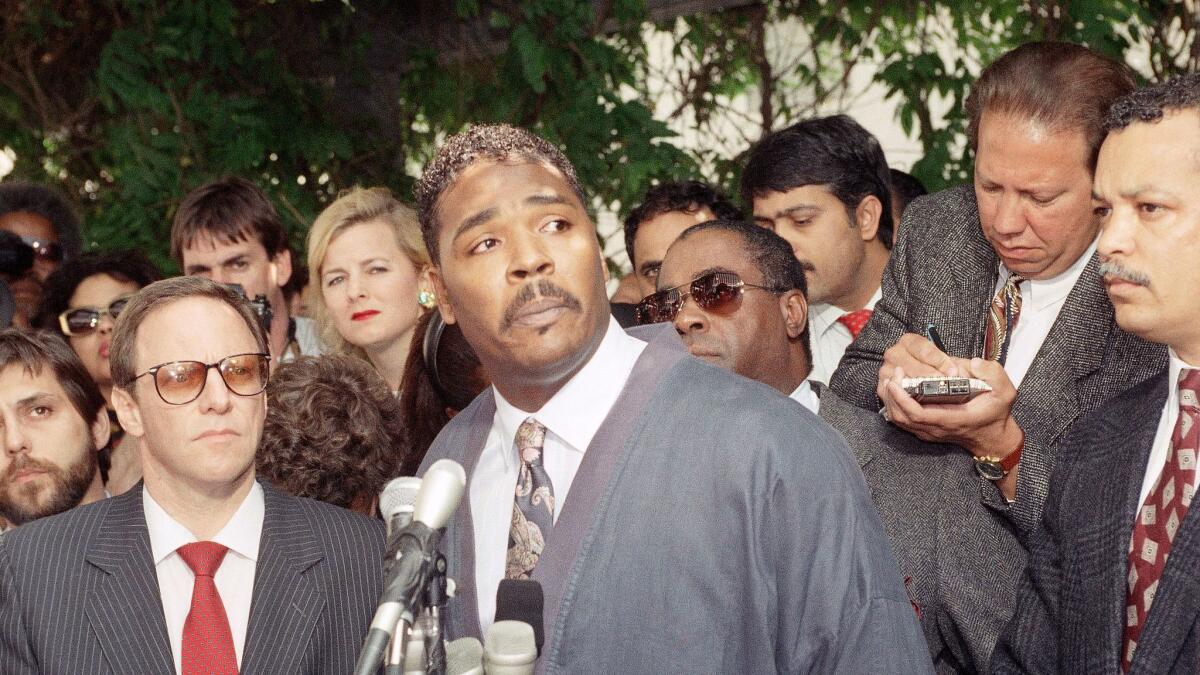Editorial: The debate over police tactics spurred by the Rodney King beating still rages on

The phenomenon that sparked six days of violence 25 years ago was not merely the beating of motorist Rodney King a year earlier, or the April 29, 1992, acquittal of four LAPD officers on all but one of the charges against them.
Anger had built up in Los Angeles over the years around other uses of force, especially against African Americans. Many went unnoticed by most Angelenos, but some incidents were well publicized, such as the fatal shooting of Eulia Love in 1979 at her home in a dispute over an unpaid bill. Later incidents, such as the killing of mentally ill homeless woman Margaret Mitchell in 1999, kept those fires burning.
Because the King beating was caught on tape and displayed police tactics to millions of viewers around the world, many frustrated observers believed that long-held grievances would finally be addressed. And in a sense, they were â but only as part of a maddeningly time-consuming process that included a federal civil rights lawsuit, a ballot measure enhancing civilian oversight and scrutiny of the Police Department, a consent decree, and an almost complete turnover in police personnel. Itâs a process that continues today.
The LAPD fatally shot more people last year than did their counterparts in other big cities, including Chicago and New York.
Has it been a success? That depends on what your yardstick is. The LAPD fatally shot more people last year than did their counterparts in other big cities, including Chicago and New York. In L.A., the Police Commission found eight shootings out of policy â the highest number in the last decade, according to a Times analysis.
Reforms recommended by the Christopher Commission after the King beating in 1991, and passed into law by voters in the wake of the riots strengthened the hand of the five-member civilian Police Commission that, at least on paper, heads the department and sets policy. Itâs the job of the chief of police â currently Charlie Beck â to carry that policy out.
In practice, things can be a bit more complex. It falls to the commission to determine whether a particular use of force followed the departmentâs policy, but that does not necessarily mean the officer involved will be disciplined if the commission deems his or her actions âout of policy.â Discipline is the purview of the chief, although his decisions are subject to independent fact-finding and review by boards of rights consisting of two of the chiefâs highest-ranking staff and one civilian. If the board finds the officer to have committed misconduct, the chief can choose to decrease the punishment called for by the board, but he cannot increase it. The commission has no role in individual discipline.
Added to the two distinct issues â whether a use of force was in policy and whether an officer should be fired or otherwise disciplined â is the question of criminal prosecution. Over the last decade and a half, the countyâs top prosecutor has brought no criminal charges against officers for shooting civilians.
Concern over the shootings has helped push the board toward policy changes that on first appearance may seem unremarkable but help drive important changes not just in police tactics but also in a confrontational police culture that for decades equated backing down with weakness. Officers have been equipped with more tasers, sponge rounds (which do not penetrate the skin) and other âless-than-lethalâ weapons. Thatâs a welcome step, although even when used properly such weapons can still be deadly.
In a more sweeping policy change, the commission now makes its decisions on whether uses of force followed policy by looking not just at the circumstances of the shooting itself â did the officer act out of a reasonable belief that lives were in danger? â but also at the actions taken beforehand. Did the officer needlessly provoke an attack? Was the initial encounter justified?
This month, the board went a step further and adopted a policy of âde-escalation,â requiring officers to do their best to defuse encounters that could, but arguably need not, become violent. It sounds good, and in practice it may change the kinds of encounters that led to the shootings of Eulia Love, Margaret Mitchell and many others.
Officers argue that they have long been trained in de-escalation tactics and would much rather arrive at a solution without firing their weapons, and some claim that the new policy merely repackages for public consumption the work they already are doing. Still, committing de-escalation to paper and including it in official department policy is an important and laudable step that helps move the department a little further away from the Rodney King era.
Follow the Opinion section on Twitter @latimesopinion and Facebook
More to Read
A cure for the common opinion
Get thought-provoking perspectives with our weekly newsletter.
You may occasionally receive promotional content from the Los Angeles Times.










